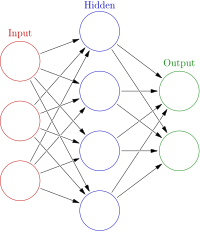
Photo from wikipedia
ABSTRACT Inter‐ and intra‐subject variability pose a major challenge to decoding human brain activity in brain‐computer interfaces (BCIs) based on non‐invasive electroencephalogram (EEG). Conventionally, a time‐consuming and laborious training procedure… Click to show full abstract
ABSTRACT Inter‐ and intra‐subject variability pose a major challenge to decoding human brain activity in brain‐computer interfaces (BCIs) based on non‐invasive electroencephalogram (EEG). Conventionally, a time‐consuming and laborious training procedure is performed on each new user to collect sufficient individualized data, hindering the applications of BCIs on monitoring brain states (e.g. drowsiness) in real‐world settings. This study proposes applying hierarchical clustering to assess the inter‐ and intra‐subject variability within a large‐scale dataset of EEG collected in a simulated driving task, and validates the feasibility of transferring EEG‐based drowsiness‐detection models across subjects. A subject‐transfer framework is thus developed for detecting drowsiness based on a large‐scale model pool from other subjects and a small amount of alert baseline calibration data from a new user. The model pool ensures the availability of positive model transferring, whereas the alert baseline data serve as a selector of decoding models in the pool. Compared with the conventional within‐subject approach, the proposed framework remarkably reduced the required calibration time for a new user by 90% (18.00min–1.72±0.36min) without compromising performance (p=0.0910) when sufficient existing data are available. These findings suggest a practical pathway toward plug‐and‐play drowsiness detection and can ignite numerous real‐world BCI applications. HIGHLIGHTSA novel subject‐transfer framework for reducing calibration time in brain state decoding.Feasibility of cross‐subject model transferring inferred from hierarchical clustering.Robust decoding performance supported by large‐scale existing data.Significant decrease in calibration time using baseline brain activity.
Journal Title: NeuroImage
Year Published: 2018
Link to full text (if available)
Share on Social Media: Sign Up to like & get
recommendations!